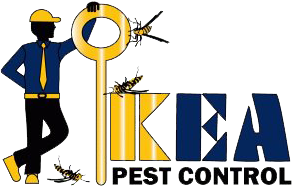Wasps and bees are beneficial insects,
although they are generally considered to be pests because of their ability to sting.
Wasps, in particular, can become a problem in autumn when they may disrupt many outdoor activities. People often mistakenly call all stinging insects "bees". While both social wasps and bees live in colonies ruled by queens and maintained by workers, they look and behave differently. It is important to distinguish between these insects because different methods may be necessary to control them if they become a nuisance.
APPEARENCE
Wasps have a slender body with a narrow waist, slender, cylindrical legs, and appear smoothed-skinned and shiny. Yellowjackets, baldfaced hornets, and paper wasps are the most common types of wasps encountered by people. Bees are robust-bodied and very hairy compared with wasps. Their hind legs are flattened for collecting and transporting pollen. Bees are important pollinators. Honey
bees are responsible for more than 80% of the pollination required by most fruits, legumes, and vegetable seed plants as well as many ornamentals that are grown in our landscapes. Bumblebees are important pollinators of native prairie plants.
FOOD PREFERENCES
Wasps are predators, feeding insects and other arthropods to their young, which develop in the nest. They are beneficial because they prey on many insects, including caterpillars, flies, crickets, and other pests. During late summer and fall, as queens stop laying eggs and their nests decline, wasps change their food gathering priorities and are more interested in collecting sweets and other carbohydrates. Some wasps may become aggressive scavengers around human food and may be common around outdoor activities where food or drinks are served. Bees feed only on nectar (carbohydrates) and pollen (protein) from flowers. Honey bees sometimes visit trash cans and soft-drink containers to feed on sugary foods.
WASP AND BEE STINGS
Wasps and bees sting to defend themselves or their colony. Stinging involves the injection of a protein venom that causes pain and other reactions. Wasps and bumblebees can sting more than once because they are able to pull out their stinger without injury to themselves. If you are stung by a wasp or bumblebee, the stinger is not left in your skin. Honey bees have barbs on their stinger which remain hooked in the skin. The stinger, which is connected to the digestive system of the bee, is torn out of the abdomen as the bee attempts to fly away. As a result, the bee soon dies. If you are stung by a honey bee, scratch out the stinger (with its attached venom gland) with your fingernail as soon as possible. Do not try to pull out the stinger between two fingers. Doing so only forces more venom into your skin, causing greater irritation. Most people have only local reactions to wasp and bee stings, although a few may experience more serious allergic reactions. Local, nonallergic reactions range from burning, itching, redness, and tenderness to massive swelling and itching that may last up to a week. These local reactions can be treated with ice, vinegar, honey, meat tenderizer, or commercial topical ointment to relieve the itching. An allergic reaction may include hives or rash, swelling away from the sting site, headache, minor respiratory symptoms, and stomach upset. These allergic reactions are not life-threatening and can be readily treated with an antihistamine. Very rarely, a person may suffer a life-threatening, systemic allergic reaction to a bee or wasp sting, which can cause anaphylactic shock (fainting, difficulty breathing, swelling, and blockage in the throat) within minutes of being stung. These systemic symptoms are cause for immediate medical attention. People with known systemic allergic reactions to bee or wasp stings should consult with their physician to obtain an Epi-PenTM or Ana-Guard Sting KitTM to carry with them at all times. The venoms of bees and wasps are different, so having a severe reaction to a wasp sting does not mean a person will have the same reaction to a bee sting.
